 |
セインさん。今日お訪ねするのは、江戸中期創業の呉服店「銀座越後屋」さんです。 銀座の中央通に面したビルが越後屋さんのビルで、お店はその1階にあります。
Thayne-san, the shop we’ll be visiting today is a kimono shop that was founded in the middle of the Edo Period. It’s called Ginza Echigoya. The Echigoya Building faces Ginza Chuo Boulevard, and the shop is on the first floor. |
|
|
 |
銀座通りとは反対側にお店の入り口があるんですね。落ち着いた、いい雰囲気の店構えですね。
I see. The shop entrance is on the opposite side of the building from Ginza Chuo Boulevard, so it has a nice relaxing appearance. |
|
|
|
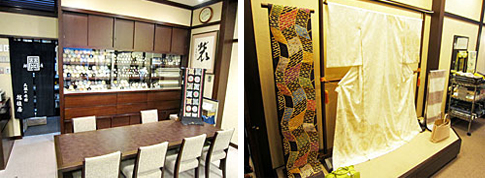 |
|
|
 |
ショーウインドウに飾られた着物や帯も、すてきですね。とっても上品で、これが銀座のセンスなんでしょうか。
The kimono and obi on display in the display window are really beautiful, aren’t they! Very refined. I suppose they match the tastes of people in Ginza. |
|
|
| (永井) |
こんにちは、セインさん、コンシェルジュさん。当主の永井甚右衛門です。
Hi Thayne-san, Concierge-san. I’m Jinemon Nagai. |
|
|
 |
はじめまして、永井さん! 今日はよろしくお願いします。それにしても、とても立派なお名前ですね。
It’s great to meet you, Nagai-san! Thanks for having us today. By the way, you have a wonderful name. |
|
|
| (永井) |
はい(笑)。この「甚右衛門」という名前は、当主が代々継いでいる名前で私も父から受け継いで、この名前になったんです。ですから、それまではごく普通の名前だったんですよ。 父が亡くなって1年ほどしてから、お役所に名前を変える届けを出して許可していただいて、襲名したんです。
Thanks. Jinemon was the name of the first owner and has been passed down generation to generation since then. I only started using this name after assuming ownership of the shop from my father. Until then I had a completely normal name. About a year after my father passed away, I went to City Hall and submitted the forms to officially adopt the professional name of my father and the previous owners. |
|
|
 |
ええっ、戸籍も変えるんですか! 役者さんの芸名のように、本名とは別に、もう一つの名前を持つんじゃないんですね。驚きました。では、初代が甚右衛門さん、というお名前だったのですね。
You don’t have two names like an actor—you really did change your official name?! I’m surprised. So the original owner’s name was Jinemon? |
|
|
| (永井) |
はい。初代甚右衛門は越後、今の新潟県の高田の出身でしたが、江戸に出てきて蕎麦屋で丁稚奉公を始めました。雑用仕事をして、ご飯を食べさせてもらって、夜は読み書き・そろばん、つまり勉強をするわけです。それで、大人になってきてある程度仕事ができるようになると、次第にお小遣いをもらえるようになる。そして、長い奉公期間を終えて独立して始めたのが藍染屋。染めの職人として、京橋に店を出しました。銀座には、2代目の時に移って来たと伝えられています。
That’s right. The original owner was from Takada in Echigo, now Niigata Prefecture. He came to Edo and started an apprenticeship under a soba shop . He did odd jobs and received board, and at night did things like reading, writing, and learning the abacus—basically, he studied. As he grew up, he struck off on his own. He opened a shop in Kyobashi as a dyer. It was apparently the second-generation owner that moved the shop to Ginza. |
|
|
 |
銀座にお店を出すなんて、初代がすごくがんばったということでしょうね。
To be able to open a shop in Ginza, the original owner must have worked really hard. |
|
|
| (永井) |
そうかもしれませんが、当時の銀座は一等地じゃありません。商業の中心は日本橋で、銀座は工場地帯。銀貨をつくる鋳造所があったので「銀座」という名前になったくらいですから。だから、安く買ったんだと思いますよ。
That might be true, but at the time Ginza wasn’t a high-class area. The center of commerce was Nihonbashi, and Ginza was full of factories. In fact, that’s how Ginza got its name—there were lots of foundries that made silver or gin coins. So I think it was actually relatively inexpensive real estate. |
|
|
 |
当時の資料は、残っていますか?
Has anything from the shop’s early days survived the years? |
|
|
| (永井) |
東京の老舗の多くは、火事やら関東大震災やら戦争やらで昔のものが残っていません。 ご他聞にもれず、ほとんど焼けてしまったのですが、帳簿などが少しだけ残っています。
Most old shops in Tokyo have little left from the old days due to fire, the Great Kanto Earthquake, or the war. Our shop is no exception; most things were lost to fire. However, some of our old ledgers survived. |
|
|
|
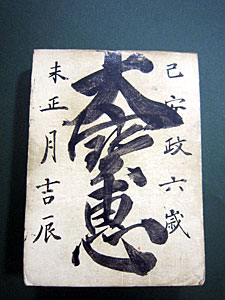 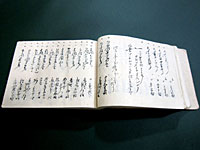 |
|
江戸後期の帳簿
A ledger from the late Edo Period |
|
|
 |
何が書いてあるのか、ちょっと僕には読めないのですが……。
I can’t quite read what it says. |
|
|
| (永井) |
いや、実は私も古文が苦手で、よくわからないんです。でも、そろそろ専門の方にお願いして、整理を始めないといけないと思っています。 大正時代に建てられた木造店舗の写真もありますよ。店の前に通っている道が、銀座中央通りです。
Actually, I’m terrible at reading classical Japanese, and I don’t fully understand it myself. I’m thinking it’s about time I asked an expert for help so I can start to put things in order. I also have a photograph of the shop that was built in the Taisho Period. It’s all wooden architecture. The road in front of the shop is Ginza Chuo Boulevard |
|
|
|
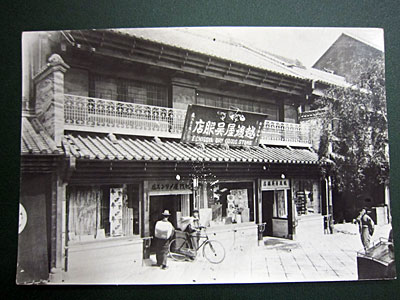 |
|
大正時代に建てられた木造2階建ての店舗
The two-story wooden shop building built in the Taisho Period |
|
|
 |
立派なお店ですね!
That’s a beautiful shop! |
|
|
| (永井) |
こちらはお客様に反物をお見せしている店内の風景。 もう1枚は大正5年の記念撮影写真なのですが前列中央が4代目で、その向かって左に5代目、左に6代目・私のおじいさんが写っています。
This one is of the inside of the shop, with a customer being shown some kimono fabric. And this photo of the staff was taken in 1916. In the center of the front row is the fourth-generation owner. To his left is the 5th generation, and to the left of him is my grandfather, the 6th. |
|
|
|
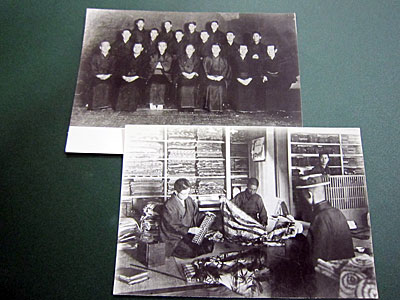 |
|
大正期の写真
Taisho Period photographs: commemorative staff photo and serving customers |
|
|
| (永井) |
そして、昭和7年に竣工したビルの写真です。
This last picture shows the new building when it was completed in 1932. |
|
|
 |
すごい建物ですね。外観もしゃれているし、店内もゴージャスですね。
How impressive! The outside of the building is quite stylish, and the inside looks gorgeous. |
|
|
|
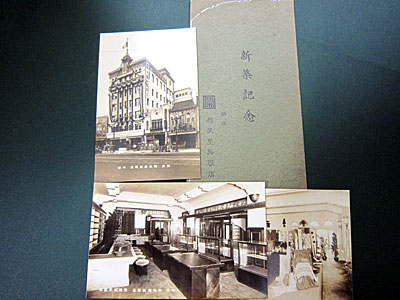 |
|
昭和7年に完成したビルの写真など。
Historical photos, including the new building completed in 1932. |
|
|
| (永井) |
ありがとうございます。 ほかには、昔の商品ラベルやらシールなどを、昔の番頭さんがきれいに整理してくれたものが残っていました。
Thank you. We also still have some of the old product tags and stickers, which the head clerk at the time organized neatly. |
|
|
|
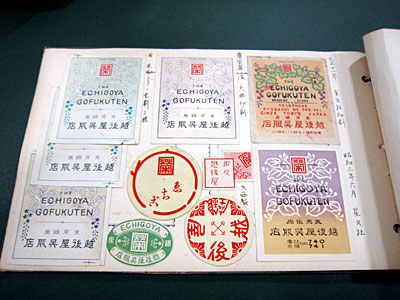 |
|
|
 |
わー、昔のデザインって、どうしてこんなにシャレているんでしょう。素敵ですね。
It’s amazing how sophisticated-looking these old designs are. They’re beautiful! |
|
|
 |
本当にお店の宝物ですね。 ところで、永井さんが今日着ていらっしゃるその着物も素敵ですね。呉服屋さんのご主人だから、着物を着ているのは当たり前のことかもしれませんが……。
They really are treasures. By the way, I really like the kimono you’re wearing too. As the owner of a kimono shop, I guess it’s only natural that you wear a nice kimono. |
|
|
| (永井) |
いやいや、僕も普段は洋服を着ているんですよ。動きやすいですからね。 でも、何かあるときはちゃんと着物を着るんです。今日も……
No, actually, on most days I wear Western clothes. They’re just easier to move around in. But on special occasions, like today, I dress up in a kimono. |
|
|
 |
あっ、私たちのために!
Oh, for us! |
|
|
| (永井) |
はい。きちんとしようと思って(笑)。 着物の良さというのはいろいろ言われていますけれど、私は、現代では非日常が味わえるところだろうと思っているんです。着物を着たとたんに、いつもと違う自分になれる。気持ちがシャンとする。おしゃれをして心が浮き立つ。
That’s right, I thought I would dress properly for you! I hear people say a lot of good things about kimono, but what I like about them is the fact that by putting on a kimono in this modern age you get a special feeling. When I put on a kimono, I’m a different person. I look smart, and it feels good. |
|
|
 |
なるほど!今日着ていらっしゃるその着物は、なんという種類なんですか?
That makes sense! What do you call the type of kimono you’re wearing today? |
|
|
| (永井) |
単衣(ひとえ)の絹の紬(つむぎ)に、博多帯。その上に紗(しゃ)の羽織を着ています。
This is an unlined hitoe kimono made of silk pongee, with a hakata obi. Over that, I’m wearing a sha haori. |
|
|
|
|
 |
紗の羽織の、ちょっと透けているところが涼しげで、粋ですね。
The slight transparency of the sha haori looks airy and cool. Very sharp. |
|
|
| (永井) |
はい。夏なので、見た目が涼しいように。着物のおしゃれの一つです。着る人よりも、見る人に涼を感じさせる趣向です。
Right, since it’s summer, I want something that looks cool to wear. That’s a key thing about kimono style—how it looks to other people is more important than how it feels to the wearer. |
|
|
 |
とても高度なファッションですね。
That’s quite a sophisticated sense of fashion. |
|
|
| (永井) |
いや、難しいことは何もないんですよ。何月何日からは単衣の着物を着てもいいとかなんだとか、うるさく言う人もいますが、その人の好きなように、その人のセンスでお召しになったらいいんです。たかが着るものですから。
There’s really nothing to it. There are some people who feel strict about it, saying, “You can only wear a hitoe kimono after this particular date,” and so on, but I think it’samatter of personal style. It’s just clothing. |
|
|
 |
それを聞いて、ちょっと安心しました。着物はなかなか着る機会がなかったんですが、挑戦してみようかな。
That makes me feel better. I don’t have many opportunities to wear kimono, but maybe I should give it a go sometime. |
|
|
| (永井) |
ぜひ! セインさんは着物体型ですから、間違なくお似合いになりますよ。
You should! You have the perfect build for wearing kimono, so there’s no doubt it would look good on you. |
|
|
  |
◎早速、ウインドーショッピングから始めましょうか。
今日はありがとうございました。
We’ll start our window-shopping right away! Thanks again for your time today. |
|
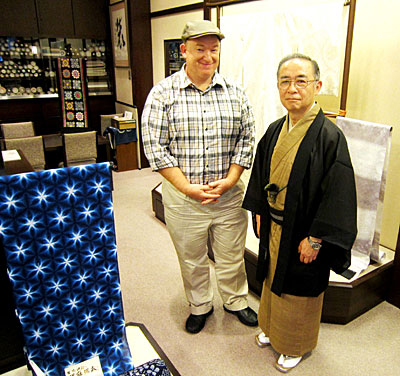 |
|
(文)太田美代
(英訳)デイビッド・A・セイン |
 1959年、米国生まれ。証券会社勤務を経て来日し、翻訳・通訳など多岐にわたって活躍。豊富な教授経験を生かし、数多くの英語関係書籍を執筆。近著に『日本人のチョットへんな英語』(アスコム)、『超入門シャドーイング』(主婦の友社)、日本人が使いすぎる英語(PHP文庫)など多数。
1959年、米国生まれ。証券会社勤務を経て来日し、翻訳・通訳など多岐にわたって活躍。豊富な教授経験を生かし、数多くの英語関係書籍を執筆。近著に『日本人のチョットへんな英語』(アスコム)、『超入門シャドーイング』(主婦の友社)、日本人が使いすぎる英語(PHP文庫)など多数。














